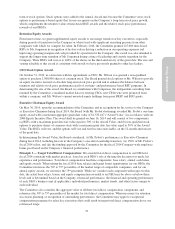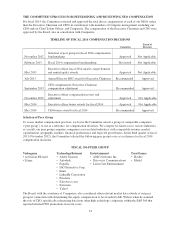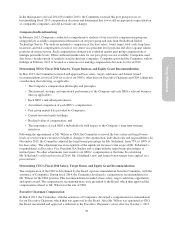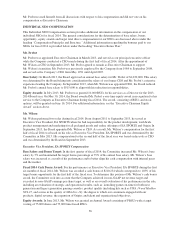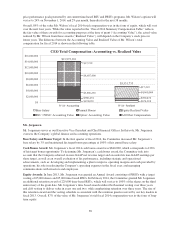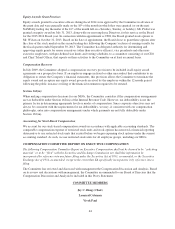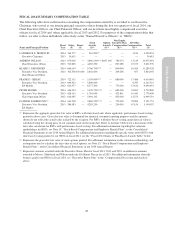Electronic Arts 2014 Annual Report Download - page 49
Download and view the complete annual report
Please find page 49 of the 2014 Electronic Arts annual report below. You can navigate through the pages in the report by either clicking on the pages listed below, or by using the keyword search tool below to find specific information within the annual report.
Proxy Statement
focus on the Company’s business without being distracted by concerns about their job security in the event of a
change of control and acts as an additional incentive for our executive officers to comply with their post-
termination covenants. The Electronic Arts Inc. Key Employee Continuity Plan provides for specified levels of
cash severance, continued health benefits and accelerated vesting of certain outstanding equity awards in the
event of a qualifying termination of employment in connection with a change of control of the Company, as
described in more detail under “Potential Payments upon Change of Control” below.
Severance Plan
We maintain an ERISA-regulated severance plan (the “Severance Plan”) that applies to (1) all of our U.S.-based
employees whose jobs are terminated due to a reduction-in-force and (2) any other employee we select to
participate in the plan upon his or her termination of employment. Under the Severance Plan, eligible employees
may receive a cash severance payment equal to two weeks of pay, with any additional payments to be determined
solely at our discretion. In addition, under the Severance Plan, we will pay the premiums for continued health
benefits, if such benefits are continued pursuant to COBRA, for a time period equal to the number of weeks of
cash severance paid.
Any severance arrangements with our executive officers, including our NEOs, whether paid pursuant to the
Severance Plan or otherwise, require the prior approval of the Committee. In the event of a change of control of
the Company, the cash severance payment payable under the Severance Plan may be reduced, in whole or in part,
by any amount paid under the Electronic Arts Inc. Key Employee Continuity Plan.
POLICIES AND PRACTICES
Stock Ownership Requirements
We maintain stock ownership requirements for all of our executive officers who are subject to Section 16 of the
Exchange Act. Historically these ownership requirements ranged from one to six times an individual’s annual
base salary depending on his or her level within the Company. In November 2013, the Board, based on a
recommendation from the Committee, approved the following changes to our stock ownership requirements.
First, we re-set the frequency for calculating share ownership requirements to an annual basis; second, for our
CEO, we reduced the ownership requirement from six times to five times his annual base salary; and third, we
added a requirement that any executive officer not in compliance with these guidelines must hold 50% of any net
after-tax shares vesting from equity awards until the applicable requirement is met. The changes were made to
better align ownership requirements between our CEO, Executive Vice Presidents and Senior Vice Presidents,
and to clarify the implications if an officer is out of compliance. As of March 31, 2014, each of our executive
officers, had either met his or her then-applicable stock ownership requirement or had not yet reached the date on
which he or she is required to meet his or her ownership requirement.
We do not have a separate requirement that Section 16 officers hold shares of the Company’s common stock for
a specific period of time after an option exercise or vesting of RSUs.
Stock Trading and Anti-Hedging Policies
We maintain a policy designed to promote compliance by all of our employees with both federal and state insider
trading laws. Under this policy, certain employees (including all of our executive officers) who regularly have
access to material, non-public information about the Company are prohibited from buying or selling shares of the
Company’s common stock during periods when the Company’s trading window is closed (unless such
transactions are made pursuant to a pre-approved Exchange Act Rule 10b5-1 trading plan). When the trading
window is open, these employees are prohibited from buying or selling shares of the Company’s common stock
while in possession of material, non-public information about the Company. During an open trading window,
employees who are subject to the trading policy and are at the level of Vice President and above must request a
trading clearance from our General Counsel prior to engaging in a trading transaction (unless such transaction is
made pursuant to a pre-approved Exchange Act Rule 10b5-1 trading plan). In addition, our Directors, executive
officers, and other employees may not engage in short sales of shares of the Company’s common stock under any
circumstances, including trading in puts and calls that increase in value from a decline in the trading price of our
stock.
43


